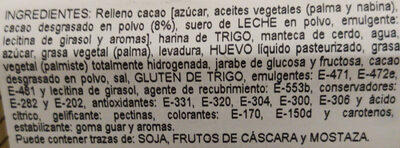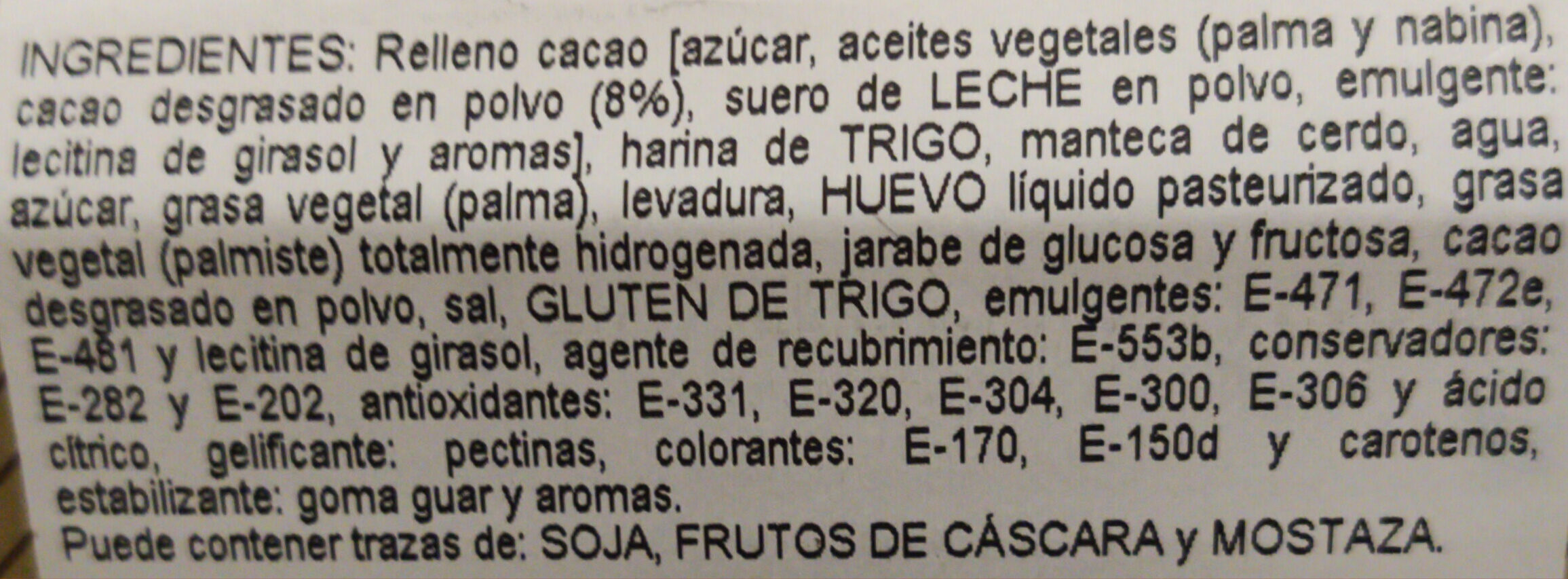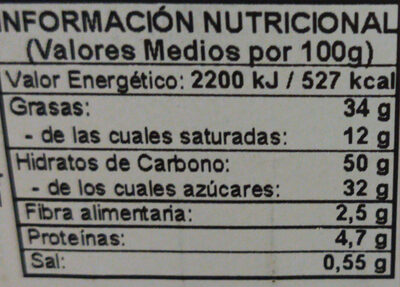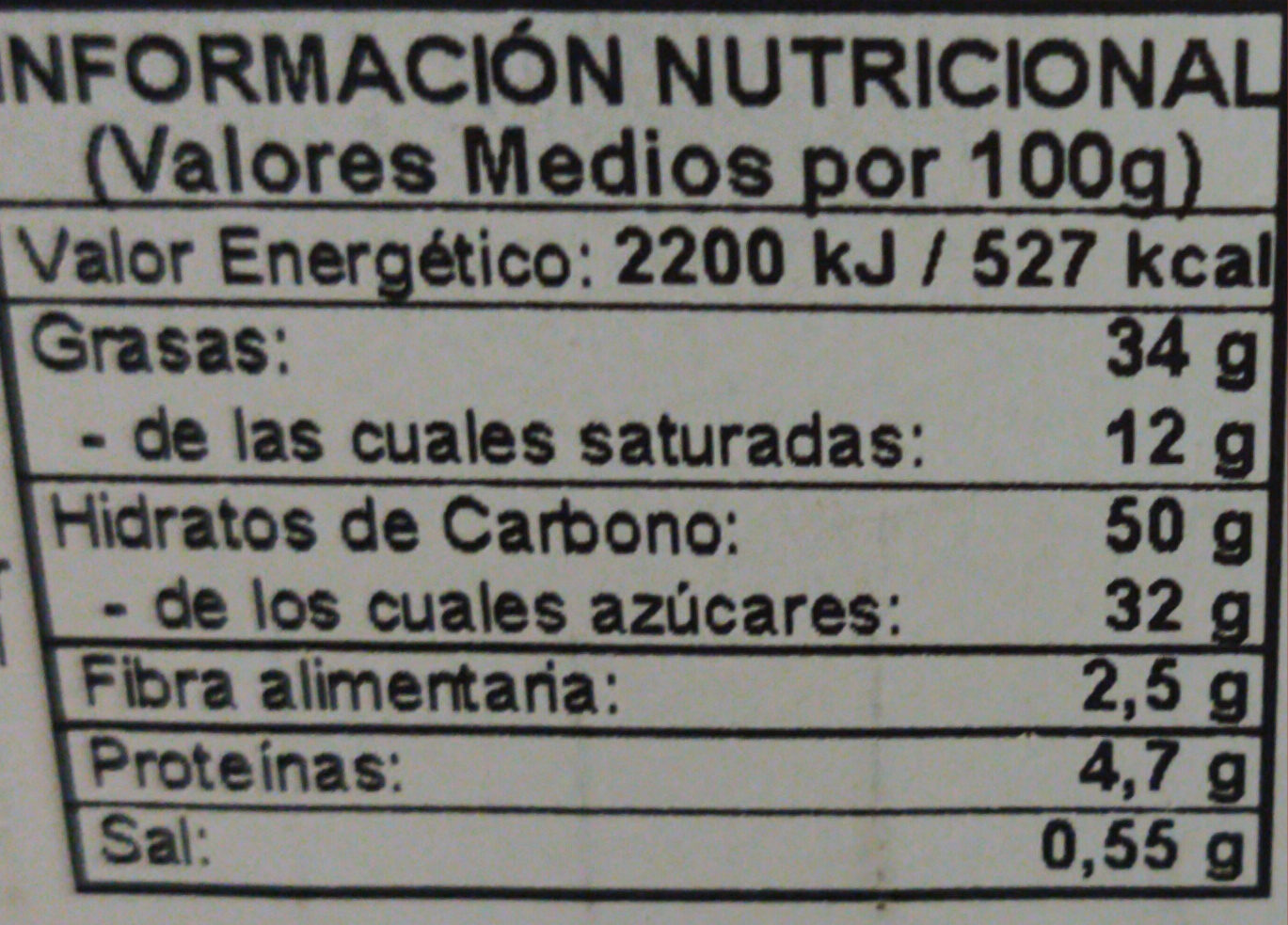Help us make food transparency the norm!
As a non-profit organization, we depend on your donations to continue informing consumers around the world about what they eat.
The food revolution starts with you!
Croissant Cacao Viruta - peiron & torrent - 280 g (8)
Croissant Cacao Viruta - peiron & torrent - 280 g (8)
This product page is not complete. You can help to complete it by editing it and adding more data from the photos we have, or by taking more photos using the app for Android or iPhone/iPad. Thank you!
×
Barra-kodea: 8436009678520 (EAN / EAN-13)
Izen arrunta: Croissant relleno de crema al cacao decorado con virutas al cacao
Kopurua: 280 g (8)
Markak: peiron & torrent
Kategoriak: en:Snacks, en:Sweet snacks, en:Sweet pastries and pies, en:Viennoiseries, en:Chocolate croissant
Etiketak, ziurtagiriak, sariak:
en:Green Dot
Traceability code: ES 20.27348/B CE
Dendak: Bonpreu
Saltzen diren herrialdeak: Espainia
Matching with your preferences
Health
Osagaiak
-
50 ingredients
: Relleno de chocolate [azúcar, aceites vegetales (palma, nabina), cacao desgrasado en polvo (8%), suero de LECHE en polvo, emulgente: lecitina de girasol y aromas], harina de TRIGO, manteca de cerdo, agua, azúcar, grasa vegetal (palma), levadura, HUEVO líquido pasteurizado, grasa vegetal totalmente hidrogenada (palmiste), jarabe de glucosa y fructosa, cacao desgrasado en polvo, sal, GLUTEN DE TRIGO, emulgentes: E-471, E-472e, E-481 y lecitina de girasol, agente de recubrimiento: E-553b, conservadores: E-282 y E-202, antioxidantes: E-331, E-320, E-304, E-300, E-306 y ácido citrico, gelificante: pectinas, colorantes: E-170, E-150d y carotenos, estabilizante: goma guar y aromas.Alergenoak: en:Eggs, en:Gluten, en:MilkAztarnak: en:Mustard, en:Nuts, en:Soybeans
Food processing
-
Ultra processed foods
Elements that indicate the product is in the 4 - Ultra prozesatutako elikagaiak eta edariak group:
- Gehigarria: E150d
- Gehigarria: E170
- Gehigarria: E322
- Gehigarria: E412
- Gehigarria: E440 - Pektina
- Gehigarria: E471
- Gehigarria: E472e
- Gehigarria: E481
- Osagaia: Colour
- Osagaia: Emulsifier
- Osagaia: Flavouring
- Osagaia: Gelling agent
- Osagaia: Glazing agent
- Osagaia: Glukosa
- Osagaia: Gluten
- Osagaia: Hydrogenated fat
- Osagaia: Esne-gazur
Food products are classified into 4 groups according to their degree of processing:
- Prozesatu gabeko edo ahalik eta gutxien prozesatutako elikagaiak
- Sukaldaritzako osagaiak prozesatu
- Prozesatutako jakiak
- Ultra processed foods
The determination of the group is based on the category of the product and on the ingredients it contains.
Gehigarriak
-
E170
Calcium carbonate: Calcium carbonate is a chemical compound with the formula CaCO3. It is a common substance found in rocks as the minerals calcite and aragonite -most notably as limestone, which is a type of sedimentary rock consisting mainly of calcite- and is the main component of pearls and the shells of marine organisms, snails, and eggs. Calcium carbonate is the active ingredient in agricultural lime and is created when calcium ions in hard water react with carbonate ions to create limescale. It is medicinally used as a calcium supplement or as an antacid, but excessive consumption can be hazardous.Source: Wikipedia (Ingeles)
-
E202
Potassium sorbate: Potassium sorbate is the potassium salt of sorbic acid, chemical formula CH3CH=CH−CH=CH−CO2K. It is a white salt that is very soluble in water -58.2% at 20 °C-. It is primarily used as a food preservative -E number 202-. Potassium sorbate is effective in a variety of applications including food, wine, and personal-care products. While sorbic acid is naturally occurring in some berries, virtually all of the world's production of sorbic acid, from which potassium sorbate is derived, is manufactured synthetically.Source: Wikipedia (Ingeles)
-
E282
Calcium propanoate: Calcium propanoate or calcium propionate has the formula Ca-C2H5COO-2. It is the calcium salt of propanoic acid.Source: Wikipedia (Ingeles)
-
E304
Ascorbyl palmitate: Ascorbyl palmitate is an ester formed from ascorbic acid and palmitic acid creating a fat-soluble form of vitamin C. In addition to its use as a source of vitamin C, it is also used as an antioxidant food additive -E number E304-. It is approved for use as a food additive in the EU, the U.S., Canada, Australia, and New Zealand.Ascorbyl palmitate is known to be broken down -through the digestive process- into ascorbic acid and palmitic acid -a saturated fatty acid- before being absorbed into the bloodstream. Ascorbyl palmitate is also marketed as "vitamin C ester".Source: Wikipedia (Ingeles)
-
E320
Butylated hydroxyanisole: Butylated hydroxyanisole -BHA- is an antioxidant consisting of a mixture of two isomeric organic compounds, 2-tert-butyl-4-hydroxyanisole and 3-tert-butyl-4-hydroxyanisole. It is prepared from 4-methoxyphenol and isobutylene. It is a waxy solid used as a food additive with the E number E320. The primary use for BHA is as an antioxidant and preservative in food, food packaging, animal feed, cosmetics, rubber, and petroleum products. BHA also is commonly used in medicines, such as isotretinoin, lovastatin, and simvastatin, among others.Source: Wikipedia (Ingeles)
-
E322
Lecithin: Lecithin -UK: , US: , from the Greek lekithos, "egg yolk"- is a generic term to designate any group of yellow-brownish fatty substances occurring in animal and plant tissues, which are amphiphilic – they attract both water and fatty substances -and so are both hydrophilic and lipophilic-, and are used for smoothing food textures, dissolving powders -emulsifying-, homogenizing liquid mixtures, and repelling sticking materials.Lecithins are mixtures of glycerophospholipids including phosphatidylcholine, phosphatidylethanolamine, phosphatidylinositol, phosphatidylserine, and phosphatidic acid.Lecithin was first isolated in 1845 by the French chemist and pharmacist Theodore Gobley. In 1850, he named the phosphatidylcholine lécithine. Gobley originally isolated lecithin from egg yolk—λέκιθος lekithos is "egg yolk" in Ancient Greek—and established the complete chemical formula of phosphatidylcholine in 1874; in between, he had demonstrated the presence of lecithin in a variety of biological matters, including venous blood, in human lungs, bile, human brain tissue, fish eggs, fish roe, and chicken and sheep brain. Lecithin can easily be extracted chemically using solvents such as hexane, ethanol, acetone, petroleum ether, benzene, etc., or extraction can be done mechanically. It is usually available from sources such as soybeans, eggs, milk, marine sources, rapeseed, cottonseed, and sunflower. It has low solubility in water, but is an excellent emulsifier. In aqueous solution, its phospholipids can form either liposomes, bilayer sheets, micelles, or lamellar structures, depending on hydration and temperature. This results in a type of surfactant that usually is classified as amphipathic. Lecithin is sold as a food additive and dietary supplement. In cooking, it is sometimes used as an emulsifier and to prevent sticking, for example in nonstick cooking spray.Source: Wikipedia (Ingeles)
-
E322i - Lezitina
Lecithin: Lecithin -UK: , US: , from the Greek lekithos, "egg yolk"- is a generic term to designate any group of yellow-brownish fatty substances occurring in animal and plant tissues, which are amphiphilic – they attract both water and fatty substances -and so are both hydrophilic and lipophilic-, and are used for smoothing food textures, dissolving powders -emulsifying-, homogenizing liquid mixtures, and repelling sticking materials.Lecithins are mixtures of glycerophospholipids including phosphatidylcholine, phosphatidylethanolamine, phosphatidylinositol, phosphatidylserine, and phosphatidic acid.Lecithin was first isolated in 1845 by the French chemist and pharmacist Theodore Gobley. In 1850, he named the phosphatidylcholine lécithine. Gobley originally isolated lecithin from egg yolk—λέκιθος lekithos is "egg yolk" in Ancient Greek—and established the complete chemical formula of phosphatidylcholine in 1874; in between, he had demonstrated the presence of lecithin in a variety of biological matters, including venous blood, in human lungs, bile, human brain tissue, fish eggs, fish roe, and chicken and sheep brain. Lecithin can easily be extracted chemically using solvents such as hexane, ethanol, acetone, petroleum ether, benzene, etc., or extraction can be done mechanically. It is usually available from sources such as soybeans, eggs, milk, marine sources, rapeseed, cottonseed, and sunflower. It has low solubility in water, but is an excellent emulsifier. In aqueous solution, its phospholipids can form either liposomes, bilayer sheets, micelles, or lamellar structures, depending on hydration and temperature. This results in a type of surfactant that usually is classified as amphipathic. Lecithin is sold as a food additive and dietary supplement. In cooking, it is sometimes used as an emulsifier and to prevent sticking, for example in nonstick cooking spray.Source: Wikipedia (Ingeles)
-
E330 - Azido zitriko
Citric acid: Citric acid is a weak organic acid that has the chemical formula C6H8O7. It occurs naturally in citrus fruits. In biochemistry, it is an intermediate in the citric acid cycle, which occurs in the metabolism of all aerobic organisms. More than a million tons of citric acid are manufactured every year. It is used widely as an acidifier, as a flavoring and chelating agent.A citrate is a derivative of citric acid; that is, the salts, esters, and the polyatomic anion found in solution. An example of the former, a salt is trisodium citrate; an ester is triethyl citrate. When part of a salt, the formula of the citrate ion is written as C6H5O3−7 or C3H5O-COO-3−3.Source: Wikipedia (Ingeles)
-
E331
Sodium citrate: Sodium citrate may refer to any of the sodium salts of citrate -though most commonly the third-: Monosodium citrate Disodium citrate Trisodium citrateThe three forms of the salt are collectively known by the E number E331. Sodium citrates are used as acidity regulators in food and drinks, and also as emulsifiers for oils. They enable cheeses to melt without becoming greasy.Source: Wikipedia (Ingeles)
-
E412
Guar gum: Guar gum, also called guaran, is a galactomannan polysaccharide extracted from guar beans that has thickening and stabilizing properties useful in the food, feed and industrial applications. The guar seeds are mechanically dehusked, hydrated, milled and screened according to application. It is typically produced as a free-flowing, off-white powder.Source: Wikipedia (Ingeles)
-
E440 - Pektina
Pectin: Pectin -from Ancient Greek: πηκτικός pēktikós, "congealed, curdled"- is a structural heteropolysaccharide contained in the primary cell walls of terrestrial plants. It was first isolated and described in 1825 by Henri Braconnot. It is produced commercially as a white to light brown powder, mainly extracted from citrus fruits, and is used in food as a gelling agent, particularly in jams and jellies. It is also used in dessert fillings, medicines, sweets, as a stabilizer in fruit juices and milk drinks, and as a source of dietary fiber.Source: Wikipedia (Ingeles)
-
E471
Mono- and diglycerides of fatty acids: Mono- and diglycerides of fatty acids -E471- refers to a food additive composed of diglycerides and monoglycerides which is used as an emulsifier. This mixture is also sometimes referred to as partial glycerides.Source: Wikipedia (Ingeles)
-
E481
Sodium stearoyl lactylate: Sodium stearoyl-2-lactylate -sodium stearoyl lactylate or SSL- is a versatile, FDA approved food additive used to improve the mix tolerance and volume of processed foods. It is one type of a commercially available lactylate. SSL is non-toxic, biodegradable, and typically manufactured using biorenewable feedstocks. Because SSL is a safe and highly effective food additive, it is used in a wide variety of products ranging from baked goods and desserts to pet foods.As described by the Food Chemicals Codex 7th edition, SSL is a cream-colored powder or brittle solid. SSL is currently manufactured by the esterification of stearic acid with lactic acid and partially neutralized with either food-grade soda ash -sodium carbonate- or caustic soda -concentrated sodium hydroxide-. Commercial grade SSL is a mixture of sodium salts of stearoyl lactylic acids and minor proportions of other sodium salts of related acids. The HLB for SSL is 10-12. SSL is slightly hygroscopic, soluble in ethanol and in hot oil or fat, and dispersible in warm water. These properties are the reason that SSL is an excellent emulsifier for fat-in-water emulsions and can also function as a humectant.Source: Wikipedia (Ingeles)
Ingredients analysis
-
en:Palm oil
Ingredients that contain palm oil: en:Palm, en:Palm, Palmiste olio
-
en:Non-vegan
Non-vegan ingredients: en:Whey powder, Txerri-gantz, en:Liquid egg, en:Fully hydrogenated vegetable fat
-
en:Non-vegetarian
Non-vegetarian ingredients: Txerri-gantz
-
Details of the analysis of the ingredients
: Relleno de chocolate (azúcar, aceites vegetales (palma, nabina), cacao desgrasado en polvo 8%, suero de LECHE en polvo, emulgente (lecitina de girasol, aromas)), harina de TRIGO, manteca de cerdo, agua, azúcar, grasa vegetal (palma), levadura, HUEVO líquido, grasa vegetal totalmente hidrogenada (palmiste), jarabe de glucosa y fructosa, cacao desgrasado en polvo, sal, GLUTEN DE TRIGO, emulgentes (e471), e472e, e481, lecitina de girasol, agente de recubrimiento (e553b), conservadores (e282), e202, antioxidantes (e331), e320, e304, e300, e306, ácido citrico, gelificante (pectinas), colorantes (e170), e150d, carotenos, estabilizante (goma guar, aromas)- Relleno de chocolate -> en:chocolate-filling - vegan: maybe - vegetarian: yes
- azúcar -> en:sugar - vegan: yes - vegetarian: yes - ciqual_proxy_food_code: 31016
- aceites vegetales -> en:vegetable-oil - vegan: yes - vegetarian: yes - from_palm_oil: maybe
- palma -> en:palm - vegan: yes - vegetarian: yes - from_palm_oil: yes - ciqual_food_code: 16129
- nabina -> en:rapeseed - vegan: yes - vegetarian: yes
- cacao desgrasado en polvo -> en:fat-reduced-cocoa-powder - vegan: yes - vegetarian: yes - ciqual_food_code: 18100 - percent: 8
- suero de LECHE en polvo -> en:whey-powder - vegan: no - vegetarian: maybe
- emulgente -> en:emulsifier
- lecitina de girasol -> en:sunflower-lecithin - vegan: yes - vegetarian: yes
- aromas -> en:flavouring - vegan: maybe - vegetarian: maybe
- harina de TRIGO -> en:wheat-flour - vegan: yes - vegetarian: yes - ciqual_proxy_food_code: 9410
- manteca de cerdo -> en:pork-fat - vegan: no - vegetarian: no - from_palm_oil: maybe - ciqual_food_code: 16530
- agua -> en:water - vegan: yes - vegetarian: yes - ciqual_food_code: 18066
- azúcar -> en:sugar - vegan: yes - vegetarian: yes - ciqual_proxy_food_code: 31016
- grasa vegetal -> en:vegetable-fat - vegan: yes - vegetarian: yes - from_palm_oil: maybe
- palma -> en:palm - vegan: yes - vegetarian: yes - from_palm_oil: yes - ciqual_food_code: 16129
- levadura -> en:yeast - vegan: yes - vegetarian: yes
- HUEVO líquido -> en:liquid-egg - vegan: no - vegetarian: yes - ciqual_food_code: 22000
- grasa vegetal totalmente hidrogenada -> en:fully-hydrogenated-vegetable-fat - vegan: no - vegetarian: maybe - from_palm_oil: maybe
- palmiste -> en:palm-kernel-oil - vegan: yes - vegetarian: yes - from_palm_oil: yes
- jarabe de glucosa y fructosa -> en:glucose-fructose-syrup - vegan: yes - vegetarian: yes - ciqual_food_code: 31077
- cacao desgrasado en polvo -> en:fat-reduced-cocoa-powder - vegan: yes - vegetarian: yes - ciqual_food_code: 18100
- sal -> en:salt - vegan: yes - vegetarian: yes - ciqual_food_code: 11058
- GLUTEN DE TRIGO -> en:wheat-gluten - vegan: yes - vegetarian: yes
- emulgentes -> en:emulsifier
- e471 -> en:e471 - vegan: maybe - vegetarian: maybe - from_palm_oil: maybe
- e472e -> en:e472e - vegan: maybe - vegetarian: maybe - from_palm_oil: maybe
- e481 -> en:e481 - vegan: maybe - vegetarian: maybe - from_palm_oil: maybe
- lecitina de girasol -> en:sunflower-lecithin - vegan: yes - vegetarian: yes
- agente de recubrimiento -> en:glazing-agent
- e553b -> en:e553b - vegan: yes - vegetarian: yes
- conservadores -> en:preservative
- e282 -> en:e282 - vegan: yes - vegetarian: yes
- e202 -> en:e202 - vegan: yes - vegetarian: yes
- antioxidantes -> en:antioxidant
- e331 -> en:e331 - vegan: yes - vegetarian: yes
- e320 -> en:e320 - vegan: yes - vegetarian: yes
- e304 -> en:e304 - vegan: maybe - vegetarian: maybe - from_palm_oil: maybe
- e300 -> en:e300 - vegan: yes - vegetarian: yes
- e306 -> en:e306 - vegan: yes - vegetarian: yes
- ácido citrico -> en:e330 - vegan: yes - vegetarian: yes
- gelificante -> en:gelling-agent
- pectinas -> en:e440a - vegan: yes - vegetarian: yes
- colorantes -> en:colour
- e170 -> en:e170
- e150d -> en:e150d - vegan: yes - vegetarian: yes
- carotenos -> en:e160a - vegan: maybe - vegetarian: maybe - from_palm_oil: maybe
- estabilizante -> en:stabiliser
- goma guar -> en:e412 - vegan: yes - vegetarian: yes
- aromas -> en:flavouring - vegan: maybe - vegetarian: maybe
- Relleno de chocolate -> en:chocolate-filling - vegan: maybe - vegetarian: yes
Elikadura
-
Bad nutritional quality
⚠ ️Warning: the amount of fruits, vegetables and nuts is not specified on the label, it was estimated from the list of ingredients: 6This product is not considered a beverage for the calculation of the Nutri-Score.
Positive points: 2
- Proteinak: 2 / 5 (balioa: 4.7, rounded value: 4.7)
- Fiber: 2 / 5 (balioa: 2.5, rounded value: 2.5)
- Fruits, vegetables, nuts, and colza/walnut/olive oils: 0 / 5 (balioa: 6.25, rounded value: 6.3)
Negative points: 25
- Energia: 6 / 10 (balioa: 2190, rounded value: 2190)
- Azukreak: 7 / 10 (balioa: 32, rounded value: 32)
- Gantz saturatua: 10 / 10 (balioa: 12, rounded value: 12)
- Sodioa: 2 / 10 (balioa: 220, rounded value: 220)
The points for proteins are not counted because the negative points are greater or equal to 11.
Nutritional score: (25 - 2)
Nutri-Score:
-
Nutrient levels
-
Koipe in high quantity (34%)
What you need to know- A high consumption of fat, especially saturated fats, can raise cholesterol, which increases the risk of heart diseases.
Recommendation: Limit the consumption of fat and saturated fat- Choose products with lower fat and saturated fat content.
-
Gantz-azido ase in high quantity (12%)
What you need to know- A high consumption of fat, especially saturated fats, can raise cholesterol, which increases the risk of heart diseases.
Recommendation: Limit the consumption of fat and saturated fat- Choose products with lower fat and saturated fat content.
-
Azukre in high quantity (32%)
What you need to know- A high consumption of sugar can cause weight gain and tooth decay. It also augments the risk of type 2 diabetes and cardio-vascular diseases.
Recommendation: Limit the consumption of sugar and sugary drinks- Sugary drinks (such as sodas, fruit beverages, and fruit juices and nectars) should be limited as much as possible (no more than 1 glass a day).
- Choose products with lower sugar content and reduce the consumption of products with added sugars.
-
Gatz arrunt in moderate quantity (0.55%)
What you need to know- A high consumption of salt (or sodium) can cause raised blood pressure, which can increase the risk of heart disease and stroke.
- Many people who have high blood pressure do not know it, as there are often no symptoms.
- Most people consume too much salt (on average 9 to 12 grams per day), around twice the recommended maximum level of intake.
Recommendation: Limit the consumption of salt and salted food- Reduce the quantity of salt used when cooking, and don't salt again at the table.
- Limit the consumption of salty snacks and choose products with lower salt content.
-
-
Nutrition facts
Nutrition facts As sold
for 100 g / 100 mlAs sold
per serving (35 g)Compared to: en:Chocolate croissant Energia 2.190 kj
(527 kcal)766 kj
(184 kcal)+% 11 Koipe 34 g 11,9 g +% 25 Gantz-azido ase 12 g 4,2 g -% 2 Carbohydrates 50 g 17,5 g +% 2 Azukre 32 g 11,2 g +% 46 Fiber 2,5 g 0,875 g -% 4 Proteina 4,7 g 1,65 g -% 10 Gatz arrunt 0,55 g 0,193 g -% 14 Fruits‚ vegetables‚ nuts and rapeseed‚ walnut and olive oils (estimate from ingredients list analysis) 6,25 % 6,25 %
Ingurumena
-
Eco-Score D - High environmental impact
The Eco-Score is an experimental score that summarizes the environmental impacts of food products.→ The Eco-Score was initially developped for France and it is being extended to other European countries. The Eco-Score formula is subject to change as it is regularly improved to make it more precise and better suited to each country.Life cycle analysis
-
Average impact of products of the same category: B (Score: 64/100)
Kategoria: Chocolate croissant, puff pastry, from bakery
Kategoria: Chocolate croissant, puff pastry, from bakery
- PEF environmental score: 0.39 (the lower the score, the lower the impact)
- including impact on climate change: 5.20 kg CO2 eq/kg of product
Stage Impact Agriculture
52.5 %Processing
39.3 %Ontziratzea
4.8 %Transportation
3.3 %Distribution
0.2 %Consumption
0.0 %
Bonuses and maluses
-
Missing origins of ingredients information
Malus: -5
⚠ ️ The origins of the ingredients of this product are not indicated.
If they are indicated on the packaging, you can modify the product sheet and add them.
If you are the manufacturer of this product, you can send us the information with our free platform for producers.
-
Ingredients that threatens species
Malus: -10
Contains palm oil
Tropical forests in Asia, Africa and Latin America are destroyed to create and expand oil palm tree plantations. The deforestation contributes to climate change, and it endangers species such as the orangutan, the pigmy elephant and the Sumatran rhino.
-
Missing packaging information for this product
Malus: -15
⚠ ️ The information about the packaging of this product is not filled in.⚠ ️ For a more precise calculation of the Eco-Score, you can modify the product page and add them.
If you are the manufacturer of this product, you can send us the information with our free platform for producers.
Eco-Score for this product
-
Impact for this product: D (Score: 34/100)
Produktua: Croissant Cacao Viruta - peiron & torrent - 280 g (8)
Life cycle analysis score: 64
Sum of bonuses and maluses: -30
Final score: 34/100
-
Carbon footprint
-
Equal to driving 2.7 km in a petrol car
520 g CO² per 100g of product
The carbon emission figure comes from ADEME's Agribalyse database, for the category: Chocolate croissant, puff pastry, from bakery (Source: ADEME Agribalyse Database)
Stage Impact Agriculture
40.2 %Processing
51.3 %Ontziratzea
5.5 %Transportation
2.9 %Distribution
0.1 %Consumption
0.0 %
Ontziratzea
-
Missing packaging information for this product
⚠ ️ The information about the packaging of this product is not filled in.Take a photo of the recycling information Take a photo of the recycling information
Transportation
-
Origins of ingredients
Missing origins of ingredients information
⚠ ️ The origins of the ingredients of this product are not indicated.
If they are indicated on the packaging, you can modify the product sheet and add them.
If you are the manufacturer of this product, you can send us the information with our free platform for producers.Add the origins of ingredients for this product Add the origins of ingredients for this product
Threatened species
-
Contains palm oil
Drives deforestation and threatens species such as the orangutan
Tropical forests in Asia, Africa and Latin America are destroyed to create and expand oil palm tree plantations. The deforestation contributes to climate change, and it endangers species such as the orangutan, the pigmy elephant and the Sumatran rhino.
Report a problem
-
Incomplete or incorrect information?
Category, labels, ingredients, allergens, nutritional information, photos etc.
If the information does not match the information on the packaging, please complete or correct it. Open Food Facts is a collaborative database, and every contribution is useful for all.
Datuen iturria
Product added on by kiliweb
Last edit of product page on by duhowpi.
Produktuaren orria -gatik editatua thaialagata, yuka.ZDRNZFM2a1psOEF3cWZBRCswUHMvc05UeTdtWlltK21LYkFMSWc9PQ.












